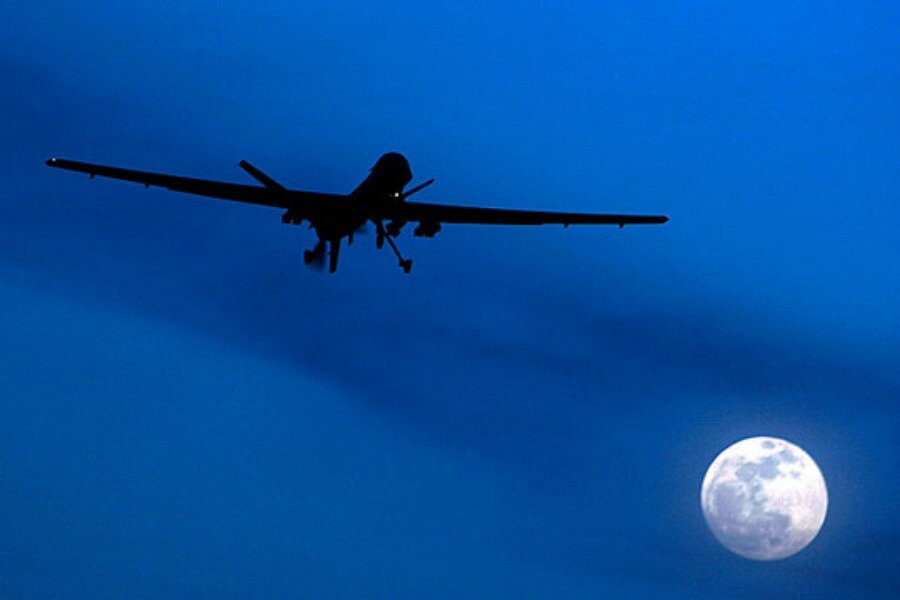Drone killing accidents reveal Obama’s tough war choices
Loading...
Barack Obama became commander in chief vowing to end America’s foreign wars as quickly as possible. Instead, he found those politically unpopular wars in Iraq and Afghanistan shifting into something else – violent conflict with different boundaries (or no boundaries), enemies from supposedly friendly countries (including American recruits), the capture and grisly killing of western hostages.
Additional US forces – especially “boots on the ground” – were out of the question, although some troops have been sent to Iraq to help confront the self-declared Islamic State. That meant increasing reliance on intelligence assets and accurately targetable weapons that would keep US troops out of harm’s way: unmanned aerial vehicles or drones.
That policy came back into sharp public focus last week with news that CIA drone strikes earlier this year had accidentally killed four individuals – two Americans associated with Al Qaeda and two hostages held by Al Qaeda, American Warren Weinstein and Italian Giovanni Lo Porto.
Speaking to intelligence professionals, President Obama expressed regret for the killing of the hostages, who the CIA did not know were in the compound with Al Qaeda subjects targeted for a drone attack.
“The one thing I wanted everybody to know – because I know you, because I work with you, because I know the quality of this team, is that we all bleed when we lose an American life, we all grieve when any innocent life is taken,” he said. "We don’t take this work lightly."
Obama also promised to “review what happened.”
“We’re going to identify the lessons that can be learned and any improvements and changes that can be made,” he said.
Will those lessons be impartially sought and taken to heart?
A task force on US drone policy, convened by the nonpartisan Stimson Center last year, expressed concern that “the Obama administration’s heavy reliance on targeted killings as a pillar of US counterterrorism strategy rests on questionable assumptions, and risks increasing instability and escalating conflicts.”
The task force also noted that “controversy has swirled around what critics view as the relative lack of transparency and accountability in US targeted killings, and the potential implications this has for domestic and international rule of law, especially if other states – including many not known for their human rights records – mimic US precedents.”
Today, writes Rachel Stohl, who was the drone policy task force project director: “If an internal critique of the U.S. drone program exists, it has been kept from open discussion and debate. Yet the most basic questions about the program have not been answered: What are the goals of the program? Are drones effective in accomplishing those goals? What metric is used to evaluate their effectiveness?”
Such questions are hotly debated.
“Technology has improved in the decade-plus since the American drone war began,” writes Matt Schiavenza in The Atlantic. ‘A second-generation armed drone called the Reaper, for example, can locate a target to a single room within a house. But drone strikes are only as accurate as the intelligence they're based on.”
“Gathering reliable intelligence in the tribal areas of Pakistan, a rugged, remote area largely beyond the federal government's control, remains a formidable challenge,” Schiavenza writes. “The nature of al-Qaeda itself – a fluid, stateless organization lacking a clear bureaucracy – makes it difficult for foreign spies to infiltrate. Terror groups have also learned how to minimize use of technology that could betray their location and activities.”
But Slate writer Will Saletan argues that “drones are the safest form of war in modern history … more discriminating and more accurate.”
“If you want to minimize civilian casualties, getting rid of drones – and steering warfare back to bombing and shelling – is the worst thing you could do,” Saletan writes, citing various studies.
In a joint letter to Obama on US drone strikes and targeted killings earlier this month, a group of civil liberties and human rights groups urged the administration to “take essential steps to: publicly disclose key targeted killing standards and criteria; ensure that U.S. lethal force operations abroad comply with international law; enable meaningful congressional oversight and judicial review; and ensure effective investigations, tracking and response to civilian harm.”
Meanwhile, writes Steve Coll in The New Yorker, the latest case of accidental killing by drone attack “reminds us that the problem with drones is not just that their operators sometimes make mistakes.”
“It is,” Coll writes, “that the heavy reliance – in time, dollars, and bureaucratic priorities—on a technological panacea for the problem of terrorism can cause a government to lose sight of the people on the ground.”
That seems to have been true here, literally as well as figuratively.








